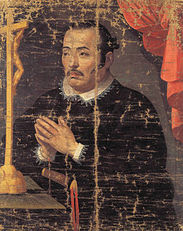 Hasekura Tsunenaga
Hasekura Tsunenaga A majority of theories put forward for this decision tend to focus on the burgeoning trade links between Spain and Japan at the time, particularly through the Spanish territories of The Philippines and Nueva Espana (Mexico). These theories emphasize Masamune’s ambitions for the northern territories to maintain a degree of financial independence from the Tokugawa Bakufu and thereby possess the capacity to remove the Tokugawa from their position at some point in the future. To realize this ambition, Masamune needed trade to flourish between Mutsu and the Spanish colony in Mexico, and allowed Spanish and Portguese merchants and missionaries to reside in his domains long after they had been expelled from other parts of Japan.
Yet as Oizumi illustrates in his book, Masamune may have had broader ambitions than this. Missionaries that were present in Mutsu and who later returned to Europe baring Masamune’s correspondence to the Spanish royal family and the Papacy emphasised that Masamune planned to have missionaries establish churches in the north to act as focal points for the more than 300,000 Christians that were believed to be in Japan at the time. The combined effect of these converts, together with technical and financial aid from the Vatican and Spanish Empire, would ensure that Masamune would possess the power to overthrow the Tokugawa and have the Date named as shōgun.
None of this was, of course, to be conveyed to the Tokugawa, who were to be convinced that the Date meant no more than trading with the Spanish than the Tokugawa did in their growing trade with the Dutch out of the East Indies. Yet the growing conviction of Tokugawa Ieyasu that the presence of Catholic missionaries in Japan presented a clear threat to the continued existence of the Tokugawa Bakufunate (a conviction fed by reports given to him by Dutch and English merchants regarding Spanish and Portguese conquests in Central and South America, India, and The Philippines), and so issued the first of a series of edicts banning the practice of proselytization in Japan, which were extended to eventually ban the presence of Catholicism in Japan in general.
Oizumi uses an extensive series of records, Japanese, Spanish, and Italian, along with French and German, to trace the manner in which Masamune sought to bring about a revolt in Japanese religious and social history. It is a work that Oizumi himself admits has taken close to half a century to bring to fruition, not least because it involved both comprehending and then translating a vast range of sources written in pre-modern versions of modern European languages. It is an impressive work, and certainly well worth reading if one has the time. It also provides more context surrounding the persecution of Christians in Japan, and why the determination of the Tokugawa to stamp out this potential threat within their midst created the social conditions depicted in Endō Shūsaku’s 沈黙, or Silence.
 RSS Feed
RSS Feed